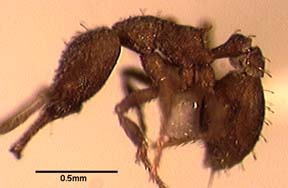
Specimen: Costa Rica, Prov. Guanacaste: Finca La Pacifica (J. Longino 530-s). INBIOCRI001283732. Image by J. Longino.


Specimen: Costa Rica, Prov. Guanacaste: Finca La Pacifica (J. Longino 530-s). INBIOCRI001283732. Image by J. Longino.
Dacetini, Myrmicinae, Formicidae, Hymenoptera, Insecta, Arthropoda, Animalia
John T. Longino, The Evergreen State College, Olympia WA 98505 USA.
21 April 1997
|
Specimen: Costa Rica, Prov. Guanacaste: Finca La Pacifica (J. Longino 530-s). INBIOCRI001283732. Image by J. Longino.
|

Specimen: Costa Rica, Prov. Guanacaste: Finca La Pacifica (J. Longino 530-s). INBIOCRI001283732. Image by J. Longino. |
Identification
Apical fork of mandible with two intercalary teeth; a conspicuous preapical tooth just proximal to the apical fork, and a preapical denticle about one third of mandible length from apical fork; outstanding setal pairs on sides of head, humeral angles, and mesonotum all similar, stiff and weakly thickened apically; gaster finely granular, opaque; erect setae on gaster spatulate; posterior face of petiolar node quadrate in posterior view, with produced anterolateral corners. [The above applies to Costa Rican material.]
Head length 0.585mm, head width 0.492, mandible length 0.333, CI 84, MI 57.
I have identified Costa Rican material as mixta based on Brown's (1962) key and type description (Brown 1953). I have not seen the types. The Costa Rican material agrees with the type description in most respects. The type material is described as having "finely flagelliform" setae on the lateral vertex border, humeral angles, and each side of the mesonotum. In Costa Rica, these setae are stiff, straight, slightly thickened at apex.
Similar species: louisianae.
Range
Guatemala, Costa Rica (northern Pacific lowlands).
Natural History
Brown and Wilson (1959) summarize the genus as follows:
"Widespread in tropics and warm temperate areas. Primarily forest-dwelling; some species occur in grassland and arid scrub. ... Nests mostly in soil and rotting wood; a few species live in arboreal plant cavities in tropical rain forest. Foraging hypogaeic to epigaeic-arboreal. Food: most species are collembolan feeders; a few are polyphagous predators or occasionally feed on sugary substances..."
The original description of mixta was based on two collections: (1) Escuintla, Guatemala (Mann), and (2) in orchid plants (Cattleya bowringeana) shipped from San Jose, Guatemala and intercepted in U.S. Plant Quarantine. The Costa Rican material is from dry forest habitat, in leaf litter on forest floor.
Selected Records
Winkler samples from Santa Rosa National Park ("bosque humedo"), La Pacifica.
Literature Cited
Brown, W. L., Jr. 1953. Three new ants related to Strumigenys louisianae Roger. Psyche 60:1-5.
Brown, W. L., Jr. 1962. The neotropical species of the ant genus Strumigenys Fr. Smith: Synopsis and keys to the species. Psyche 69:238-267.
Brown, W. L., Jr., Wilson, E. O. 1959. The evolution of the dacetine ants. Quart. Rev. Biol. 34:278-294.